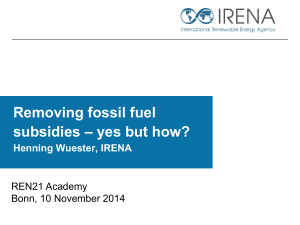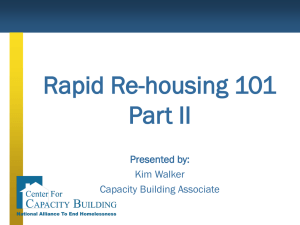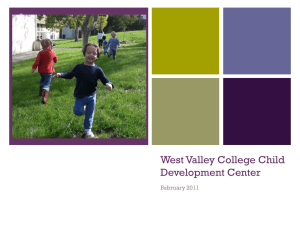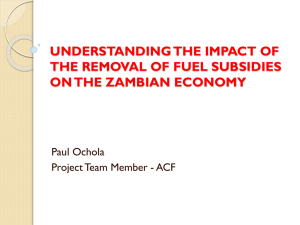Investment Priority for Poverty Reduction and Higher Agricultural
advertisement
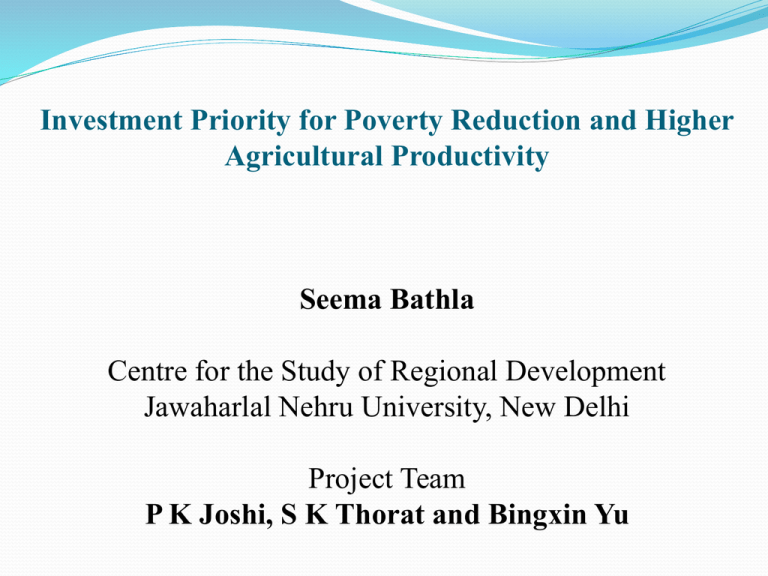
Investment Priority for Poverty Reduction and Higher Agricultural Productivity Seema Bathla Centre for the Study of Regional Development Jawaharlal Nehru University, New Delhi Project Team P K Joshi, S K Thorat and Bingxin Yu Rationale for Public Investment •Social benefits from agricultural expenditure are far greater than the private producer benefits •Amount spent by private sector tends to be lower than the socially optimal level, and this under-provision creates a rationale for the public provision of such goods •Literature abounds on the positive impact of public expenditures on agricultural output and poverty in developing economies (Fan and Rao (2008), Fan and Brzeska (2010), Mogues et al. (2012) Public spending “in agriculture” and “for agriculture” Rapid growth of productivity drives agricultural growth and is key to poverty alleviation, mostly through technology adoption & increased spending on R&D (Fan et al. 2006; Nin-Pratt, Yu and Fan 2009; Fuglie 2010). The Prescription: If government has an additional billion rupees to spend on agriculture, it should be spent on investments rather than subsidies to achieve higher agricultural growth and rural poverty reduction. In other words, input subsidies “crowds out” public investments in agriculture. Literature (IFPRI 1999; 2002 & many others) Suggested : •A reversal in the declining trend in public investments in agriculture witnessed during the 1980s and 1990s • Subsidies tend to be unproductive due to low marginal returns A check on the rising level of farm input subsidies, no matter how important they have been for agricultural growth The Scenario during the 2000s •A phenomenal increase in the public investment (capital formation) in agriculture •Investment on private account has grown at a much higher rate •Input subsidies continue to rise at nearly 3% per annum; a higher growth in credit subsidy is identified in recent period •Magnitude of input subsidies in 2000s three times higher than public investment in agriculture compared to four times during the 1990s Annual Rate of Growth in Agriculture Investment and Input Subsidies from 1981-2012 at 2004-05 price (Rs. Billion) Average Public GCFA Private GCFA GCFA Input Subsidy Irrigation Credit Power Fertilizer Input Subsidy/ Capita (Rs.) 1981-1989 105 231 336 347 36 19 54 235 618 1990-1999 92 329 422 476 62 14 201 195 744 2000-2011 175 769 945 639 86 47 257 248 825 1981-2011 127 461 588 502 64 29 180 227 739 Annual Rate of Growth (Percent) 1981-1989 -3.70 1.79 0.14 8.04 8.69 12.36 21.09 4.99 6.13 1990-1999 2.78 3.11 3.06 2.49 2.49 -10.24 11.87 -4.24 1.43 2000-2011 6.38 8.75 8.25 3.18 3.19 9.99 2.33 2.98 1.52 1981-2011 3.27 6.39 5.64 2.60 3.21 3.96 6.65 0.12 1.00 Source: Finance Accounts, GOI, Agriculture Statistics at a Glance, Statistical Abstract of India, Fertilizer Statistics. Note: Irrigation subsidy is estimated from 1983-84 onwards . Public and private GCFA is up to 2010-11. 1400 1100 1200 1000 900 1000 800 800 700 600 600 500 400 400 Public Investment Agriculture Input Subsidy 2011 2009 2007 2005 2003 2001 1999 1997 1995 1993 1991 1989 200 1987 0 1985 300 1983 200 1981 Public and Private GCFA Fig.1 : Public and Private Investment in Agriculture and Input Subsidy, Rs. Billion at 2004-05 Price Private Investment Agriculture Fig. 1b: Tradeoff between Public Investment and Farm Input Subsidy, Rs. Billion at 2004-05 Prices 250 1200 200 1000 800 150 600 100 400 50 200 0 0 Public Investment Agriculture Input Subsidy Fig.2a Agricultural Expenditure and Input Subsidies, in billion Rupees Note: Fertilizer subsidy taken from Fert. Stat. is apportioned to states as per consumption; Other subsidies based on the difference between suppliers’ costs and revenues received from farmers. Fig. 2b:Trends in Input Subsidy in Agriculture, Rs. Billion at 2004-05 Price 700 600 500 400 300 200 100 0 Irrigation Credit Power Fertilizer Fig. 3: Percentage Share of Input Subsidy in Agriculture Income 25 20 15 10 5 0 Input Subsidy Per NSDPA Fig. 5: Regional Disparities in Input Subsidy Per Ha Rs. at 2004-05 Prices (Average 1981 to 2011) 6500 5500 4500 3500 2500 1500 Input Subsidy/ Crop Area TN Punjab Haryana AP Gujarat UPUttra Karnataka JK Kerala UP Maharashtra BihJhar WB HP MPChat Rajasthan Odisha Assam 500 Fig. 6: Regional Disparities in Per Capita Public Expenditure 7500 6500 5500 4500 3500 2500 1500 500 Per Capita Development Expenditure Structure of Social and Economic Expenditure and Share, Average 2000-11 Social welfare & nutrition Welfare of SC, ST & backward classes Medical & public health Rural development Irrigation & flood control Economic services Agriculture & allied services Rural energy Education & sports Rural road & transport Village & small industries Percentage Share of Various Heads of Expenditure in Total (Av. 1981 to 2011) Share of capital exp. (%) 1981-1989 19901999 2000- Growth 2011 rate (%) Total exp. (billion rupees) 1412.2 2427.3 5245.0 6.6 12.3 Development exp. (billion rupees) 1034.9 1589.8 3283.4 5.8 17.9 Social exp. (billion rupees) 516.9 827.2 1763.1 6.3 5.56 Economic exp. (billion rupees) 517.9 762.6 1519.7 5.4 31.0 100 100 100 5.4 Agriculture & allied services 21.8 22.0 17.3 4.2 9.1 Rural development 15.0 14.9 12.9 4.6 6.7 Irrigation and flood control 33.1 26.8 23.7 3.9 55.7 Rural energy 1.3 4.3 5.4 12.2 28.9 Rural road and transport 9.9 8.6 11.4 1.8 9.3 Village and small industry 2.84 2.35 1.37 1.76 45.6 Average share within head (%) Economic services Average share within Agriculture (%) Share of 2000- Growth capital exp. 2011 rate (%) (%) 19811989 19901999 Agriculture & allied services 100 100 100 4.2 Crop husbandry 23.1 27.9 27.8 5.8 2.5 5.9 6.9 5.7 3.9 20.9 Animal husbandry 11.6 11.4 10.9 3.9 2.3 Dairy development 13.6 8.5 4.6 -1.9 2.1 2.3 2.5 2.5 4.7 17.7 22.3 19.7 19.1 3.8 10.6 Plantations 0.4 0.1 0.9 - 71.2 Food, storage warehousing 2.5 5.4 10.2 - - Agri. research and education 6.3 6.2 7.3 4.8 1.8 Agri. financial institutions 0.8 0.7 0.02 -- -- 11.1 10.4 11.1 4.0 21.7 0.8 0.9 0.7 3.7 17.1 Soil and water conservation Fisheries Forestry and wildlife Cooperation Other agri. Programs Development and Non-development Expenditure (Rs. Billion) 2011-2012 2009-2010 2007-2008 2005-2006 2003-2004 2001-2002 1999-2000 1997-1998 1995-1996 1993-1994 1991-1992 1989-1990 1987-1988 1985-1986 1983-1984 1981-1982 0 1000 2000 3000 Development 4000 5000 Non-development 6000 7000 8000 Estimating the Relative Impact of various Subsidies and Investments on Agricultural Growth and Poverty reduction Conceptual and Analytical Framework Public Spending Investments Subsidies Food Sec & Empl Progs Other exog. var.. Pop. growth, agro-eco factors, urban growth, macro and trade policy and world price AgriInputs Soc Serv: Edn, Health, Welfare Infra: Irrigation, Power, Road Agriculture Productivity and Growth Non-agri Empt: (MNREGA, Vill Ind etc.) Non-farm Wages Farm Wages Food prices Rural Poverty Red line indicates indirect effect Tech: Fert, Seeds, R&D 1. RPoverty = f1(AY, TOT, AWage, NFEmpl , Pop Density, Rain) 2. Agri Income (AY) = f2 (Agri Research, Land, Labour, IRRI, ELECT, LITE, FERT, ROAD, Rain, NFSM-Dummy) 3. AWAGE = f3(GDPGNA, AY, ELECT, ROAD, LITE, HealthExp, MNREGAdummy) 4. NFEmpl= f4(GDPGNA, NA Wage, ROAD, LITE, ELECT, RurDev Exp, Vill Ind Exp, MNREGA ) 5. TOT = f5(AY, World price, GDPGNA) 6. FERT = f6(Input subsidies , TOT(-1), IRRI, Agri Research, ROAD, ELECT) 7. IRRI = f7(Irrigation Exp., TOT, Power Subsidy, Rainfall) 8. ELECT = f8(Energy Exp.) 9. ROAD = f9(Road-transport Exp.) 10.LITE= f10(Education Exp.) Changes Introduced based on IFPRI (2007) •Data base based on Finance Accounts ; consistent from 1981-82 to 2011-12 based on 1987 budgetary classification •Agriculture income taken to be land productivity instead of labour productivity •Literacy replaced with the number of years of schooling •No. of villages electrified replaced with power consumption in agriculture •Inclusion of non-agricultural wage rate •Dummy to capture the impact of MNREGA and National Food Security Mission during 2000 •Impact of Change in Policy Regime (election dummy to capture change in the government ) •Public capita public expenditure is specified in lag as well as in stock terms •Expenditure on agriculture research & development broaden to include expenditure on soil conservation and crop husbandry -Methodology : Both Structural Econometric Model based on Maximum Likelihood Estimation and 3SLS (SURE) -Use of double log functional form -Inclusion of state and time effects -Time period : 1981-1989; 1990-1999 and 2000-2011 based on 17 states data. Newly formed states combined (Jharkhand, Uttrakhand and Chattisgarh) with old ones -Test of model specification: endogeneity, identification, multicollinearity, specification and measurement errors -Hausman test shows a few subsidies and expenditure variables to be endogenous. One year lag is taken to address the problem. -Sargan test used for identification -Alternate equations to address multicollinearity Estimated Rural Poverty Equation Agricult ure Income TT Agricultu Non Farm re Employm Wage ent (% Share) Rain Con R2 stant Likeliho od Ratio -0.21** -0.49* -1.17* -0.06 0.07 10.7 0.82 * 4781.6 1980s N=136 -0.18* -0.42* 0.19*** -0.25* -0.01 7.9* 0.96 1899.98 1990s N=170 -0.63* -1.88* -- 0.001 0.12* * 17.0 0.83 2* 2484.55 2000s N=204 -0.47* -2.65* -0.29 -1.29* 0.35* 22.6 0.89 * 2928.09 19812011 N=510 *,**,*** indicate significance at 1, 5,10% level. State effects significant. TOT is 3 yrs moving average. Agricultural wage and non-farm employment are correlated during 1990s. Estimated Agriculture Income (Land Productivity) Equation Fertilize Irrig Labour Rain r ation Agri cultu re R& D Agri. Educa Roa d Electr tion icity Consu mptio n NFS M Cons R2 tant 19812011 0.12* 0.14 * 0.09* 0.04* 0.08 * 0.11* 0.23* 0.01 0.07* 7.8* 0.9 5 1980s 0.15* -- 0.10 0.22* 0.07 *** -0.03 0.17 0.22 *** -- 5.46 0.9 7 * 1990s 0.11* 0.05 *** 0.02 -- 0.06 0.13* 0.49* 0.16 * -- 7.84 0.9 6 * 2000s 0.43* 0.09 * 0.26* -- 0.25 -0.12* 0.35* -0.03 * -- 4.59 0.8 6 * Variables specified on per ha basis; public expenditure is per capita; GCA/worker dropped due to multicollinearity; NFSM dummy from 2006. extended agri-research variable correlated so the original variable (agri R&D is taken. Estimated Agriculture Wage Equation Agricultur Agri. Road Educati Health MGNR GDP C R2 e Income Electricity Density on Expenditu EGA GNA Consumptio re n 19810.34* -0.01 0.15* 0.43* 0.29* -0.01 -0.27 - 0.8 2011 3.2 8 * 1980s 0.23* 0.03** -0.02 0.42* -0.01 -- -0.25 0.7 0.4 9 7 1990s 0.24* 0.03** 0.04 0.34* 0.22* -- -0.05 - 0.5 0.7 7 4 2000s 0.25* 0.02*** 0.002 0.94* 0.17* -0.03 -0.48 - 0.6 1.1 6 1** Variables specified on per ha basis; public expenditure is per capita Estimated Non-farm Employment Equation Non Farm Wage Agri. Electricity Consumpti on Road Educa Rural MG Density tion Devel NRE opme GA nt Villag GDP e GNA Indust ry Co R2 nst ant 0.17 -0.12* 0.43* 2.1 0.79 * 5 19812011 0.14* 0.09* 0.05 0.69* 0.09* 1980s -0.32* 0.06* 0.42* 0.39* 0.02 -- -0.03 -0.07 1.2 0.96 0* 1990s 0.12** * -0.04 0.03 0.38* ** 0.01 -- -- 0.4* 3.8 0.89 4* 2000 0.05** * 0.11* 0.005 0.93* -0.02 0.01 -0.02 0.21* 1.9 0.97 5* Variables specified on per ha basis; public expenditure is per capita Estimated Agriculture Price (TOT) Equation GDPGN Trend Consta R2 nt A Agriculture Income World Price 1981-2011 -0.36* 0.17* 0.31* 0.03* -43.94* 0.72 1980s -0.35* 0.11 0.29* 0.02* -37.61* 0.89 1990s -0.11*** 0.13*** -0.05 0.01* 26.93* 0.79 2000s -0.21* 0.29* 0.17*** 0.02* -26.26* 0.85 Estimated Agril. Production Equation (captured through Fertilizer Demand ) Irriga Power Fertilize Cred Agricu TOT tion Subsid r it lture (-1) Subsi y Subsidy Subs R&D dy idy Roa Irriga Tren Const R2 ant d tion d Den sity 0.05** 0.44* 0.36 0.06* * -- -3.14 0.9 4 0.21* -- -4.18 0.9 2 1981- 0.04* 2011 0.01 0.39* -- 1981- 0.11* 2011 0.02 -- 0.01 1980 s -0.02 0.07* 0.46* 0.43 0.08** * 0.08 -- 1990 s 0.05* ** -0.06 0.07* 0.73* 0.12 * 0.07* -0.18 -- -0.01 0.65* 0.04 * 0.07* 0.01 -- 2000 s 0.47* 0.73 0.07* * * 0.12* - 72.51 0.8 * * 0.04 ** 9 ** 0.05 0.03 - 0.9 * 77.25 4 * 0.20* - 100.4 0.8 0.05 * 8 * Variables specified on per ha basis; public expenditure is per capita; Multicollinearity between fertilizer and credit subsidy during 19812011 Irrigation (Share of Irrigated Area in total) Equation Public Power Expenditure Subsidy on Major and medium irrigation Terms of Trade Constant R2 1981-2011 0.16* 0.05* 0.12** 1.54* 0.87 1980s 0.07* -0.01 -0.10 3.65* 0.98 1990s 0.08 0.05 -0.36 4.09* 0.89 2000s 0.10* -0.001 0.18** 2.16* 0.96 Public expenditure is in stock terms and specified on per capita basis; Rainfall is correlated with other explanatory variables so dropped. Electricity (Share of Power Consumption in Agriculture in Total) Equation Public Expenditure on Rural Energy Constant R2 1981-2011 0.24* -1.49* 0.89 1980s 0.18* -2.05* 0.94 1990s 0.11* -0.72* 0.96 2000s -0.04 0.58* 0.97 Road (Road Density Total) Equation Public Expenditure on Rural Road and Transport Constant R2 1981-2011 0.25* 5.16* 0.92 1980s 0.18* 5.34* 0.98 1990s 0.29* 4.89* 0.97 2000s 0.10* 6.2* 0.95 Literacy (No. of Years of Schooling) Equation Public Expenditure on Education Constant R2 1981-2011 0.65* -3.05* 0.91 1980s 0.43* -1.98* 0.98 1990s 0.46* -1.89* 0.96 2000s 0.34* -0.91* 0.92 Broad Findings • Investments in agriculture (both public and private) have increased at a much faster rate during 2000 compared to subsidies; subsidies not crowded out public investment •Investment & subsidy distribution across states continues to be extremely unequal •Relative decline in expenditure on economic heads – Agriculture, irrigation and rural development have born the maximum brunt •Land productivity, non-farm employment and agriculture prices have significant impact on poverty reduction •Road & electricity appear to have a decreasing impact on land productivityFertilizer, irrigation, education, Agriculture R&D and NFSM dummy significant •Rural wages are increasingly affected by agril. productivity and education but decreasingly affected by road density •Urban growth, education & non-farm wages have increasing impact on nonfarm employment •Agricultural prices are negatively affected by agricultural growth and positively by world prices and urban growth •Power and irrigation subsidies have relatively decreasing impact on production (captured through fertilizer use). Investments vs Input Subsidies based on Estimated Marginal Returns Returns in Agricultural GDP (Rs per million Rs Spent) Ranking 1981- 19812011 1989 1990-1999 2000-2011 1981-2011 1981-1989 1990-1999 2000-2011 Agriculture R&D 21.36 30.38 24.71 45.27 1 2 2 1 Education Inv 3.39 3.59 3.58 4.29 4 5 4 5 Health Investment 6.89 -0.29 6.10 3.67 2 10 3 4 3.27 6.63 2.28 0.01 5 4 6 7 1.50 1.36 0.40 0.75 8 7 9 6 Rural Energy Investment 3.54 6.60 2.86 0.11 3 3 5 9 Rural Development 1.37 0.75 0.35 -0.44 10 9 10 10 Irrigation Subsidy 2.67 -1.57 -3.26 -3.82 6 11 11 11 Fertiliser Subsidy 2.28 1.28 2.12 8.87 7 8 7 2 Power Subsidy 0.84 1.61 1.25 -0.11 11 6 8 8 Credit Subsidy 1.49 64.29 33.58 4.60 9 1 1 3 Rural Road & Transport Inv Irrigation Investment Returns in Rural Poverty (Decrease in number of poor per million Rs spent) Ranking 1990198119901981-20111981-1989 1999 2000-2011 2011 1981-1989 1999 2000-2011 Agriculture R&D 982 2463 1278 1278 1 2 2 1 Education Investment 156 291 185 121 4 5 4 5 Health Investment 317 -24 315 104 2 10 3 4 Rural Road & Transport Inv Irrigation Investment Rural Energy Investment Rural Development Irrigation Subsidy Fertiliser Subsidy Power Subsidy Credit Subsidy 150 538 118 0.4 5 4 6 7 69 110 21 21 8 7 9 6 163 535 148 3 3 3 5 9 63 61 18 -12 10 9 10 10 123 -127 -169 -108 6 11 11 11 105 39 104 131 109 65 251 -3 7 11 8 6 7 8 2 8 69 5213 1738 130 9 1 1 3 Implications • Absence of tradeoff between productivity and poverty reduction from public spending on various heads and subsidies •Fertilizer and credit subsidies have large growth effects in 2000: No more unproductive and compete with public investment. If macro fiscal policy allows more funds towards more investments and subsidies, then no issue •Returns are relatively higher from fertilizer and credit subsidies compared to rural energy and irrigation subsidies –Focus on their rationalisation rather reduction •Marginal impact of investment in rural energy on agril productivity has declined •High returns to investments from road and irrigation have subsided; but expenditure should be there for maintenance ; Regional impact may stand imp. • Roads-transport investment holds importance for non-farm employment and hence poverty reduction. •Agriculture research continues to be the most effective public spending item followed by health, education , irrigation & credit subsidy; to increase it and also the investment intensity •Non-farm opportunities to be increased through agro-processing (not much effect of rural development and village industry) Thank you!



